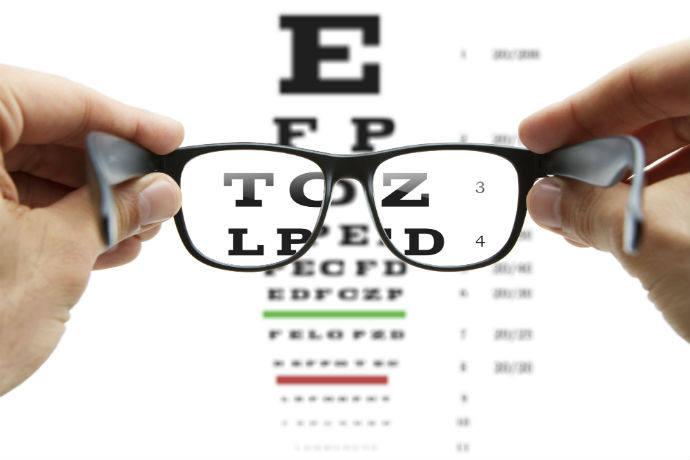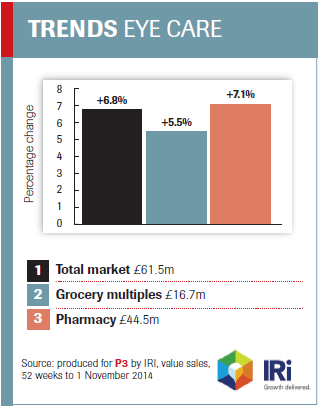Close up on eyes
In Insight
Follow this topic
Bookmark
Record learning outcomes
An ageing population is the driving force behind the increase in sight loss and poor eye health. Help advise customers on how to look after their eyes
Almost two million people in the UK are living with sight loss and by 2020 the number is set to rise to over 2.25 million and around four million by 2050.
Our ageing population is a major factor in this increase, with one in five over- 75s living with sight loss and half of those over 90.
 Other factors include obesity, diabetes and smoking, which all increase risk of sight problems. However, sight loss is not inevitable and there's plenty that pharmacy staff can do to help customers preserve their sight and care for their eyes. According to the RNIB, over 50 per cent of sight loss is avoidable and the main factor is poor uptake of sight tests, with 20 million of us failing to get our vision checked once every two years and one in 10 never having had an eye examination.
Other factors include obesity, diabetes and smoking, which all increase risk of sight problems. However, sight loss is not inevitable and there's plenty that pharmacy staff can do to help customers preserve their sight and care for their eyes. According to the RNIB, over 50 per cent of sight loss is avoidable and the main factor is poor uptake of sight tests, with 20 million of us failing to get our vision checked once every two years and one in 10 never having had an eye examination.
'It's important that pharmacists refer customers to opticians instead of the GP. Opticians have more in-depth knowledge about the eye and the right equipment to properly diagnose a customer's eye condition,' advises Valerie Steiner, OTC marketing manager at Bausch & Lomb.
Older customers
Almost two-thirds of sight loss cases in older people are caused by refractive error and cataract, both of which can be diagnosed by an eye test.
Age-related macular degeneration €“ Some 415,000 are living with wet AMD and 194,000 with dry AMD in the UK, while almost 1.5 million are living with the early stages. The condition affects the macula and causes loss of central vision. It's most common in over-65s and smoking increases the risk.
First signs include problems reading small print, blurred central vision and straight lines being distorted. Customers with any of these signs should be referred to an optometrist.
Cataracts €“ As we get older, the lens becomes less transparent, making vision blurred. Earlysigns to watch for include cloudy vision, needing more light to read small print and colour vision changes. Customers should be referred to an optometrist for diagnosis and referral.
Glaucoma €“ Caused by optic nerve damage, it's most common in over-65s. It runs in families and is also more common in people with diabetes. Regular sight tests are the best way of picking up early signs. Ocular hypertension increases risk and by 2020 an estimated 602,000 will be living with it.
 Sight tests are essential for older customers. Those over 70 should have an annual test and
Sight tests are essential for older customers. Those over 70 should have an annual test and
those younger every two years. Remind customers that this is free for over-60s and ask when they last had their eyes tested. 'There is a strong association between poor vision and falls, so it's advisable to ask customers who may have suffered a fall if they have had a sight test lately and are wearing spectacles with an up-to-date prescription,' says Francesca Marchetti
representing National Eye Health Week.
One issue your customers may not be aware of is the importance of good lighting as you get older, says Age UK. Your eyes need twice as much light at age 40 as at 20 and three times as much at 60. (For more information see www.pocklington-trust.org.uk to download a free guide 'Making the most of your sight: improve the lighting in your home').
Pharmacies can help by stocking a good range of reading glasses, as well as optical aids such as magnifiers for older customers.
Eye health and smoking
This year's No Smoking day, this month, has a focus on the links between smoking and poor
eye health. A poll of 2,000 smokers by the British Heart Foundation found only one in five smokers in the UK is worried about how smoking will affect their eyes.
'Smoking speeds up the ageing process, including ageing of the eyes. The best way to reduce the risk of developing conditions that will impact eye health is to quit smoking,' says Dr Mike Knapton, BHF medical director. This is something pharmacy staff can get involved with when talking to customers about smoking cessation this month.
 At National Eye Health Week, Ms Marchetti comments: 'The link between smoking and sight loss is as strong as the link between smoking and lung cancer, yet smokers still appear to be unaware they risk losing their sight.'
At National Eye Health Week, Ms Marchetti comments: 'The link between smoking and sight loss is as strong as the link between smoking and lung cancer, yet smokers still appear to be unaware they risk losing their sight.'
The campaign highlights the link between smoking and AMD (www.nosmokingday.org.uk). Smokers double their risk of developing AMD, says the RNIB, and tend to develop it earlier than non-smokers. 'Smoking is also linked with cataracts, thyroid eye disease, dry eye and poor colour vision. The good news, however, is that quitting can halt, and in some cases, reverse, damage done to your eyes. One study suggests a smoker who quit 20 years ago has the same chance of developing AMD as a non-smoker,' says Ms Marchetti.
Dry eye
Around 30 per cent of people suffer from dry eye and 49 per cent say it makes them feel depressed, while 41 per cent of sufferers don't acknowledge or recognise the condition, according to allergan. Dry eye is the most common cause of eye irritation in over-65s and women are more likely to be affected. However, research by Thea Pharmaceuticals last year showed two-thirds of optometrists have seen an increase in the number of younger patients presenting with eye problems, including dry eye.
'This could be due to a number of reasons, including poor diet, smoking and increased use of screens,' says Melanie Tymm, product manager at Thea Pharmaceuticals.
'Dry eye has a major impact on quality of life €“ sufferers are three times more likely to have difficulty with everyday activities such as driving, reading and using the computer. Left unattended, it can lead to temporary loss of vision. There is a real need for pharmacy staff to recognise the symptoms and provide the right treatments,' says Kirsten Hamilton-Bond at Allergan.
It's an area where customers would welcome pharmacy advice. 'When it comes to eye health, self-diagnosis is high. Our research found over 30 per cent of people who experience symptoms of dry eye or blepharitis admitted they would selfdiagnose using the internet or self-select treatment.
Pharmacy plays a vital role in ensuring that customers choose the correct solutions for their symptoms,' says Ms Tymm. 'On average, sufferers experience dry eye symptoms 13 days each month, so it's important for pharmacy staff to become better informed about the condition,' says Ms Hamilton-Bond.
One in five of over-75s and half of those over the age of 90 are living with sight loss
Make the most of your eye care category
- 'The message we're trying to get across to both pharmacy staff and customers is that you don't need to treat common eye conditions like conjunctivitis, blepharitis or styes with antibiotics every time. There is a range of alternative treatments which are all now widely available €“ the supply problems of recent years have been resolved,' says Sandi Sims, marketing manager at Cambridge Healthcare Supplies.
- Spread the message about antibiotic resistance. 'There's been a lot of coverage about
antibiotics resistance with coughs and colds, but it applies to their use with eye infections, too. Pharmacists are well placed to both advise and provide OTC remedies,' Ms Sims.
- 'It's key for pharmacy staff to be able to spot different eye condition symptoms. We have new wall charts available which illustrate these for display in pharmacy,' adds Ms Sims.
- 'To enhance customer support, it's beneficial for staff to learn about the types of lifestyle
activities that can impact on dry eye (eg air conditioning, computers) and tips on how to
reduce symptoms through lifestyle changes,' says Ms Hamilton-Bond. - Have plenty of information on display about eye conditions and the treatments available.
- 'Pharmacists can reinforce the health benefits of regular eye tests with an optometrist to ensure any potential issues are accurately identified and managed at the first sign to prevent serious eye problems. A healthy diet and smoking have important implications for vision into old age,' says Ms Tymm.
- 'Pharmacists should advise customers to use topical products which are preservative free
where possible, especially for customers with allergies or inflammation,' adds Ms Tymm. - Group and display products according to treatment options and ingredients to help
customers select more easily. - 'Taking part in initiatives such as National Eye Health week is a great way to promote the
importance of regular sight testing and highlight how taking care of your eye health can help improve overall wellbeing,' says Ms Marchetti.
Eye care updates
Thea Pharmaceuticals is the first company to offer a fully preservative-free and perfume-free range, with formulations available for dry eye (Hyabak, Thealoz) and a range of lid hygiene products (Blephaclean, Blephasol). This year the company is launching an education campaign on the importance of eye health and how nutritionals can maintain healthy eyes. The focus will be on the supplement Nutrof Total.
Allergan has launched dry eye product Optive Fusion. A complete dry eye solution, it combines hyaluronic acid, carboxymethyl cellulose and osmoprotectants for better relief with fewer drops. It's being supported by a marketing campaign featuring four eyeball icons, each depicting different symptoms of dry eye.
Bausch & Lomb has launched Biotrue rewetting drops, a product designed for mild dry eye, in a 10ml and single-dose format. Also new is Artelac range, a complete dry eye solution designed to provide long lasting moisturisation. Artelac Rebalance is for day use and gives sustained, non-blurring vision for people with recurrent dry, tired and irritated eyes. Artelac Nighttime gel gives three layers of film stability for overnight comfort.
A survey by Bausch & Lomb's eye care supplement Ocuvite found that 42 per cent of us believe worsening eye health is inevitable, although sight was the sense they valued most. Ocuvite contains a combination of nutrients to protect eye health, including DHA, zinc, vitamin C, vitamin E, lutein and carotenoids.
Comment
 Reena Barai, SG Barai Pharmacy, Sutton 'This category has lots of different elements to it, and we allocate a whole shelf to it. Dry eye is quite common, say for women of a certain age, and can be associated with medications. We tend to suggest hypromellose. Lately, we have had increasing presentations of blepharitis, and seem to be seeing it more often. We suggest sterile cleasing wipes, and the hospital clinic recommends cleansing with diluted baby shampoo. Then, people come for advice for eye problems associated with allergies, although I find that we are now limited in the choice of antihistamine eye drop that we can offer €“ some that I used to recommend I have not been able to get hold of. We no longer stock contact lens solutions or reading glasses (people either go to the pound shop or their opticians for glasses now).'
Reena Barai, SG Barai Pharmacy, Sutton 'This category has lots of different elements to it, and we allocate a whole shelf to it. Dry eye is quite common, say for women of a certain age, and can be associated with medications. We tend to suggest hypromellose. Lately, we have had increasing presentations of blepharitis, and seem to be seeing it more often. We suggest sterile cleasing wipes, and the hospital clinic recommends cleansing with diluted baby shampoo. Then, people come for advice for eye problems associated with allergies, although I find that we are now limited in the choice of antihistamine eye drop that we can offer €“ some that I used to recommend I have not been able to get hold of. We no longer stock contact lens solutions or reading glasses (people either go to the pound shop or their opticians for glasses now).'
 Fiona McElrea, Whithorn Pharmacy, Whithorn 'This can be a busy category, particularly at certain times of the year. We operate a PGD to treat minor eye infections using chloramphenicol as a POM, which has been set up locally, mostly to reduce costs. We tend to recommend Opticrom for allergy eye issues, and this is available on the minor ailments scheme. The Actimist spray is a popular one. The category can be a confusing one for customers I find, although many of the products have the same ingredients. Dry eye seems to be increasing as a problem, perhaps because our increasing use of computers and devices. I know that opticians feel that eye problems are likely to continue to increase €“ children are using devices all the time and lessons are even taught on whiteboards at school. It's a growing category for all ages.'
Fiona McElrea, Whithorn Pharmacy, Whithorn 'This can be a busy category, particularly at certain times of the year. We operate a PGD to treat minor eye infections using chloramphenicol as a POM, which has been set up locally, mostly to reduce costs. We tend to recommend Opticrom for allergy eye issues, and this is available on the minor ailments scheme. The Actimist spray is a popular one. The category can be a confusing one for customers I find, although many of the products have the same ingredients. Dry eye seems to be increasing as a problem, perhaps because our increasing use of computers and devices. I know that opticians feel that eye problems are likely to continue to increase €“ children are using devices all the time and lessons are even taught on whiteboards at school. It's a growing category for all ages.'
 Dilip Patel, Mirage Pharmacy, Handsworth 'Eye care is a fairly big section for us €“ we probably see someone once or twice a day. I think this is one where there is potential to expand. Demand for cosmetic eye products €“ for people who are worried about red eyes €“ seem to be up on last year. In the hayfever season people come and ask generally for 'something for itchy eyes', rather than a specific brand. We tend to recommend sodium cromoglicate or Otrivine. Other people have problems with dry eye €“ perhaps from a smoky atmosphere or from eye strain from spending a long time on the computer. We suggest hypromellose or a brand.'
Dilip Patel, Mirage Pharmacy, Handsworth 'Eye care is a fairly big section for us €“ we probably see someone once or twice a day. I think this is one where there is potential to expand. Demand for cosmetic eye products €“ for people who are worried about red eyes €“ seem to be up on last year. In the hayfever season people come and ask generally for 'something for itchy eyes', rather than a specific brand. We tend to recommend sodium cromoglicate or Otrivine. Other people have problems with dry eye €“ perhaps from a smoky atmosphere or from eye strain from spending a long time on the computer. We suggest hypromellose or a brand.'
